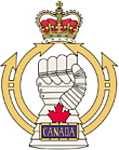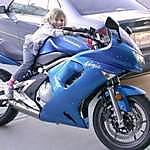I spent over 10 years on tracked and wheeled armoured vehicles. I think that a lot of the answers here are good ones.
-Most of the reference material for WWII models is in black and white. It is hard to tell what is rusty and what is not. There is artistic licence used without doubt. Modellers have used construction equipment as reference material.
-Most WWII tracked vehicles used all metal tracks. Most modern tracked vehicles use rubber track pads. Tracks with rubber track pads weather differently than all metal tracks....that's the purpose of the track pads...to increase the life of the track, i.e. less contact on the roads...therefore more exposure to the elements.
All metal tracks have much more contact with off road and road surfaces..therefore they weather more, i.e a tank that has being travelling on roads or cross country will have nice worn shiny exposed surfaces.
That being said the shiny exposed surfaces will be for the most part the surfaces that come in contact continually with the ground. The rest of the track will be covered in some sort of surface dust. this is of course if the surface is dry.
Tracks exposed to large amounts of wet mud or snow weather differently than those used continually in dry conditions.
- The rust present on the tracks of a used armoured vehicle is strictly surface rust and does wear off quickly when the vehicle is in use. There can be combinations of rust, road dust, and shiny bare metal on the same track link.
Track center guides will be rubbed bare from contact with the road wheels.
Modern end connectors will have surface rust, ground dust, and small bare patches.
Rubber track pads fade, wear down, and have chunks torn out.
I would imagine that in WW II that track links were used to their maximum wear in combat. You just can't stop in combat and change a drive sprocket because the wear indicator shows the drive sprocket teeth are worn down. You can find plenty of images with Allied Shermans showing broken off track extenders.
Use you reference material to your advantage, if you like it then do it. Weather your vehicle according to how much it was used, what type of surfaces it travelled on, what time of the year it being built to portray, how fresh or old off the production line it was, and if it is combat or peacetime.
There appears to be a ton of research into projects in regards to what size bolt goes where and what shade of paint should be used but not enough discussion about how an actual armoured vehicle wears and weathers.
I hope this helps a few folks out.
Hosted by Darren Baker
Why rusty tracks?

LeoCmdr

Joined: January 19, 2005
KitMaker: 4,085 posts
Armorama: 3,917 posts

Posted: Monday, February 20, 2006 - 11:00 AM UTC
Posted: Monday, February 20, 2006 - 03:24 PM UTC
Quoted Text
Most WWII tracked vehicles used all metal tracks. Most modern tracked vehicles use rubber track pads. Tracks with rubber track pads weather differently than all metal tracks....that's the purpose of the track pads...to increase the life of the track, i.e. less contact on the roads...therefore more exposure to the elements.
All metal tracks have much more contact with off road and road surfaces..therefore they weather more, i.e a tank that has being travelling on roads or cross country will have nice worn shiny exposed surfaces.
Not sure about your side of the pond, but over here the rubber pads are a pre-reqisuite to taking a tracked vehicle on the road. Army or not, you won't be allowed to take non rubber padded tracks on to the public roads. Something about damage to the surface...
Cheers
Henk

LeoCmdr

Joined: January 19, 2005
KitMaker: 4,085 posts
Armorama: 3,917 posts

Posted: Monday, February 20, 2006 - 06:20 PM UTC
Yes, I agree that rubber track pads reduce the wear and tear and road surfaces. I figured that was a given and did not state it. I have seen many APCs and tanks damage curbs with end connectors while still having rubber track pads. Rubber track pads on WW II AFVs were to increase the life of the track. Rubber pads on modern tanks appear far more on Western tanks that ex-Soviet built/ infuenced AFVs. There were and are still exceptions...the Centurion until the Hush Puppy tracks were installed and the Merkava and Magachs.
This is what Diehl states about their track and what advantages it has, note that nothing is stated about road surfaces, it's all about getting the most for the buyers money:
"The best results in terms of long service life and low maintenance requirements are achieved with a one-piece track shoe using induction-hardened track pins and end connectors as well as replaceable track pads.
The main advantages of the Diehl System Track include:
Low life-cycle cost
Reduced maintenance
Easy handling - quick-fit® pads
No replacement of end connectors
Only wearing parts to be replaced: running track pads
The optimal solution for use with tracked vehicles is provided by the double-pin track. The essential elements of this system are the body, the rubberized track pins proper (two per track shoe), the Diehl push-in track pad (without bolts or nuts), the self-clamping end connectors and the center guide. This system also offers extra traction in the form of the so-called snow or mud grousers."
This is what Diehl states about their track and what advantages it has, note that nothing is stated about road surfaces, it's all about getting the most for the buyers money:
"The best results in terms of long service life and low maintenance requirements are achieved with a one-piece track shoe using induction-hardened track pins and end connectors as well as replaceable track pads.
The main advantages of the Diehl System Track include:
Low life-cycle cost
Reduced maintenance
Easy handling - quick-fit® pads
No replacement of end connectors
Only wearing parts to be replaced: running track pads
The optimal solution for use with tracked vehicles is provided by the double-pin track. The essential elements of this system are the body, the rubberized track pins proper (two per track shoe), the Diehl push-in track pad (without bolts or nuts), the self-clamping end connectors and the center guide. This system also offers extra traction in the form of the so-called snow or mud grousers."

gcdavidson

Joined: August 05, 2003
KitMaker: 1,698 posts
Armorama: 1,563 posts

Posted: Monday, February 20, 2006 - 11:35 PM UTC
For what it's worth, here is my M113 after a 4 week exercise. This picture was taken about 15 minutes after I brought it back from the wash rack. The road from the washracks to the bays is paved.
You can see bright silver wear on the guide teeth and on the hull where the end connectors have gouged the alloy.
Note that despite being washed & driven on pavement, the tracks are still a rusty brown colour.
Interestingly, some of the wheels showed rust (steel wheels?) while on one, the paint wore completely off exposing a dull silver finish. They were brand new wheels I helped install prior to start-ex.

You can see bright silver wear on the guide teeth and on the hull where the end connectors have gouged the alloy.
Note that despite being washed & driven on pavement, the tracks are still a rusty brown colour.
Interestingly, some of the wheels showed rust (steel wheels?) while on one, the paint wore completely off exposing a dull silver finish. They were brand new wheels I helped install prior to start-ex.
 |









